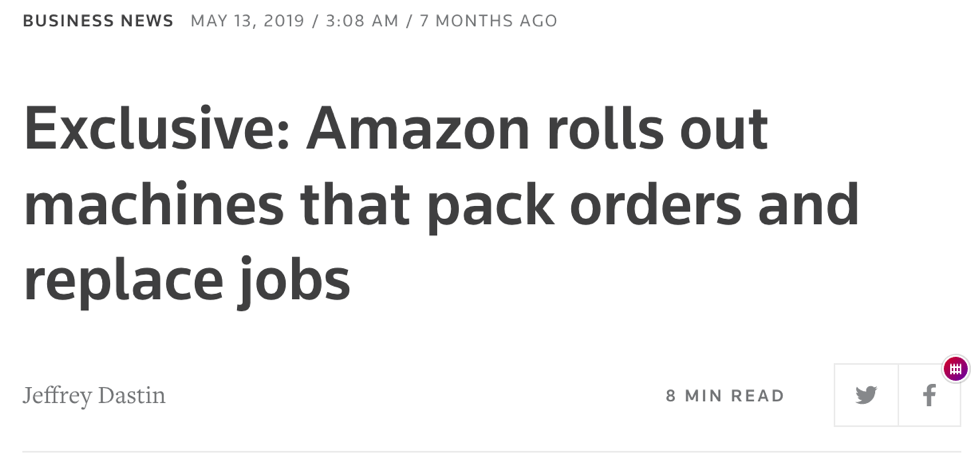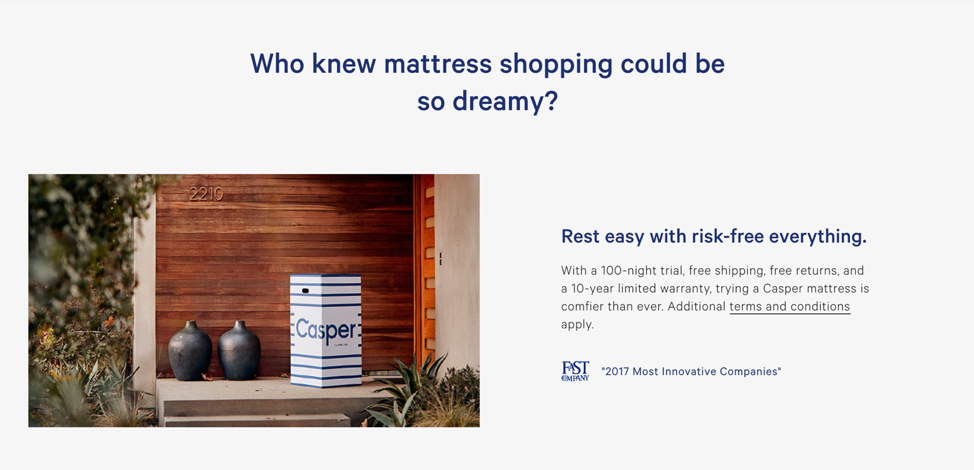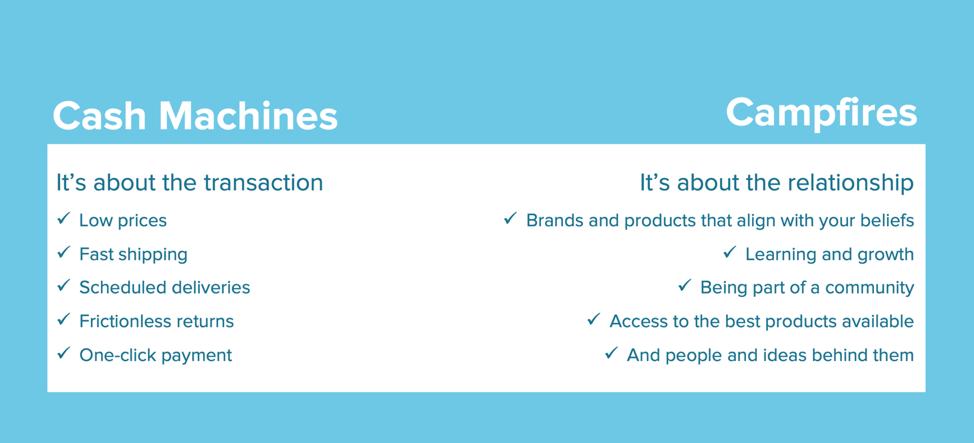Which DTC experience are you building: a cash machine or a campfire?

Brian Hennessy
Talkoot CEO and Co-Founder
Brands that can build campfires, should.
I love autopay. I love it as only someone who used to sit at their kitchen table for an hour every week signing checks, stuffing envelopes and licking stamps could.
In the days before the internet, every week was filled with hours of mindless to-dos like scribbling down directions, copying documents and developing photos — tasks that are all now (blissfully) in our collective rearview mirror. All of which now frees me up to binge watch Queer Eye with my daughters, tease my sister in Chicago over social media, and stream How I Built This while I work.
Less meaninglessness. More meaning.
If you could boil down the beauty of the digital age into a single sentence it would be this: The Internet frees us from a whole mess of meaningless to-dos so we can spend more time connecting with people, ideas and content we actually find meaningful. This gets at the two great benefits of the internet: 1) shedding meaninglessness from our lives through radical efficiency (e.g., autopay) and, 2) adding meaning to our lives through radical engagement (e.g., Netflix, Insta and Spotify).
Today, there are millions of ecommerce sites offering up an endless stream of goods on the internet. But if you look at the most successful ecommerce brands — whether it’s DTC, pure retailers or marketplaces — the experiences they’ve built all fall at extremes of that same continuum: radical efficiency versus radical engagement.
Cash Machine Commerce: One transaction please, hold the human.
Everybody needs to bank. Nobody likes to bank. A cash machine reduces a meaningless, repetitive task to its most efficient, streamlined form by removing the human element. Amazon works like a cash machine. But instead of withdrawing money, we put our credit card in and withdraw daily necessities like garbage bags, AAA batteries, power cords and socks. No human needed or wanted. Same for Jet, Zappos, Google shopping and Walmart. Cash Machine commerce is all about creating the most time- and cost-efficient transaction possible by removing the humans.

Though DNVBs like Warby Parker and Casper feature beautifully designed websites and gorgeous photography, their real value hinges on their ability to provide the lowest-friction transaction in their industry. Same cash machine, prettier lobby. There is no tribe of inexpensive eyeglass or mattress-in-a-box diehards looking to connect with each other in that lobby. Instead these companies simply saw an industry with difficult-to-sell-online products and digital-laggard competitors. They were able to enter the market by reducing the transaction costs standing between customers and the products they need.

Campfire Commerce: Experiences we gather around for warmth.
Then there are Campfire Commerce sites that have found success by being what Amazon can’t be. They’ve created experiences people want to gather around by telling stories and building relationships based on shared beliefs and attitudes. Though most offer a relatively polished checkout and quick shipping, their customers will tell you convenience and low prices miss the point. What they come for are the beliefs and belonging. Which is why they’re able to publish popular magazines, found active social networks and launch loyalty programs that actually inspire loyalty, not bargain hunting.
“Before the final bricks were laid on this interior wall of the store, members of the Shinola team hand wrote all the names of the 2,500 original buyers on this wall. We took a photo of this and sent that in an email to them, along with a note that said, ‘You were with us in the beginning, now you will be with us always. You believe in us as much as we believed in ourselves and that will never be forgotten.” — Shannon Washburn, President of Shinola

How can you tell the difference?
At first glance, you could easily confuse Warby Parker’s business model for Glossier’s. They both look and feel like modern, digital-first retailers targeting young consumers. But if you dig a bit deeper into their experience, you’ll see Warby is hyper-focused on the transaction. It was hard to order prescription glasses online. Warby solved it. Same is true with Casper and Dollar Shave Club. They feature novel transactional models that allow consumers to order products that are traditionally difficult to purchase online. Their sites don’t feature much content or other pathways for consumers to connect. Though well designed, these are textbook cash machine experiences.
Glossier.com, on the other hand, has pioneered no clever transactional model. Instead, they’re hyper-focused on creating deep relationships. Their site is filled with rich content, stories and articles all created around a singular point of view: people-powered beauty. Same is true with cotopaxi.com, Shinola.com and Patagonia.com. These are campfire experiences that draw people together to, not just buy products, but buy into a worldview.

Don’t get caught in the middle.
Legacy brands struggling to establish a strong DTC channel often attempt a middle path, carefully designing an experience that alienates no one. What they actually do is create an experience that inspires no one. By trying to play both an efficiency and engagement game, they fail at both. They can’t hope to match the efficiency and low prices of Amazon. They also don’t seem to have the organizational will to invest in the kind of deep, valuable customer relationships that fuel the meteoric growth of their DNVBs competitors. Instead, they languish in the unloved, unprofitable middle of the market.

What to do? Use Jeff Bezos’ own advice against him.
Jason Fried, the CEO and co-founder of Basecamp, talks about the most important advice Jeff Bezos gave him early on in Basecamp’s history, “Find the things that won’t change in your business and invest heavily in those things.”
Bezos realized that customers will never tire of lower prices and more convenience. That makes sense. Mostly. There will never be a moment in my life when I don’t want my favorite toilet paper or phone charger easier to acquire and at a lower price (then again, one never knows).
But even more than low prices and convenience, I’ll never tire of connecting with people I admire and supporting organizations and movements I believe in. I’ll click past 30%-off banner ads all morning long to buy a full price jacket from a brand like Patagonia, I trust and believe in. I like helping Shinola bring manufacturing jobs back to Detroit and laughing my butt off at Shinesty’s latest screaming-eagle undies. You may disagree. But young, affluent consumers don’t. You can hear how much these companies care about what they’re creating. It comes pouring through every blog post, email, video and PDP story. And I want to be a part of it.
No matter where the journey of digital transformation takes us, we will never tire of gathering together around campfires to talk and laugh and learn.
